Prince George's christening to take place at St James's Palace chapel next month
- Thread starter Blackleaf
- Start date
You are using an out of date browser. It may not display this or other websites correctly.
You should upgrade or use an alternative browser.
You should upgrade or use an alternative browser.
15. (1) Every individual is equal before and under the law and has the right to the equal protection and equal benefit of the law without discrimination and, in particular, without discrimination based on race, national or ethnic origin, colour, religion, sex, age or mental or physical disability.Class systems are most common to banana republics, fascist powers and insecure people. Most aren't as "in your face" is Britain.
I don't class myself equal to a Chav family on some sink estate.
I am of a higher class than them.
For the first time since 1894, the sovereign has been photographed with the next sovereign, the one after that and the one after that.
Here is monarch number 40 with numbers 41, 42 and 43 in the post-1066 chart.
Other than Victoria in 1894, it is the ONLY time in British history that a monarch has been able to look their three successors in the eye.
It is a perfect example of the continuity that the monarchy brings and shows the British monarchy, and the House of Windsor, is secure well into the 22nd Century.
The photo is one of the official Prince George christening photos taken by Jason Bell which have been released. In one photo, of the little new prince with just his parents, Prince George appears to be cheering!
Making history, a queen and three kings in waiting: The first photograph to show four sovereigns together since the Victorian period
The dress code was lounge suits, the protocol low-key. But if Prince George’s christening hardly smacked of a state occasion, it will certainly be regarded as a momentous one by posterity.
For this photograph is the first time the world has seen the Queen alongside the next sovereign, the one after that and the one after that.
Here is monarch number 40 with numbers 41, 42 and 43 in the post-1066 chart.

Line of succession: The Queen is flanked by Prince William, holding Prince George, and Prince Charles. The first time a British monarch has been pictured with three heirs since Queen Victoria in 1894
This official picture is more than just an enchanting family scene. It will appear in every history book on the British monarchy years after everyone featured in it has gone.
And the historians will not only be focusing on the baby. They’ll be talking about the Queen.
It is an image with instant and obvious echoes from an earlier age. Because just one other monarch in history has had the pleasure of looking three successors in the eye — the Queen’s great-great-grandmother.
That moment was captured when Queen Victoria attended the christening of Prince Edward of York — the future Edward VIII — at White Lodge in Richmond Park in 1894.
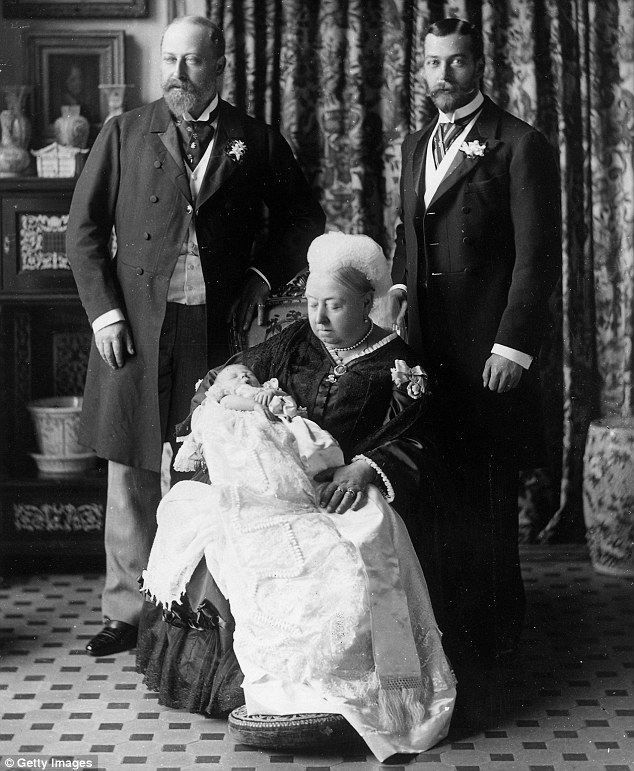
Queen Victoria (Elizabeth II's great-great-grandmother) holds her great-grandson the future King Edward VIII (Elizabeth II's uncle) with her son the future Edward VII (left, Elizabeth II's great-grandfather) and her grandson the future George V (right, Elizabeth II's grandfather) at White Lodge in Richmond Park, London, in 1894
He lies on Queen Victoria’s lap — a baby who will live to see the Moon landings, held in the arms of a woman born in the reign of George III.
Behind the severe-looking great-grandmother (despite producing nine children, Victoria famously detested small babies), stand the Prince of Wales, the future Edward VII, and the Duke of York, the future George V.
Now reflect on the span of history in the photo from Prince George’s christening.
Here is a (much happier) Queen, born in the year of the General Strike (1926), alongside a great-grandson who, when he reaches her age, will be leading the monarchy into the 22nd century.

Queen Victoria and Prince Albert taken in May 1854. Victoria famously detested small babies
What the scene underlines, in a typically understated way, is the fact that our Queen is right up there alongside Victoria in the pantheon of the greats.
In any hereditary organisation — or business for that matter — the primary duty of the boss is to hand it on in at least as good a state as he or she found it.
For if a constitutional monarchy stands for anything, it is for continuity, for permanence.
Victoria certainly achieved that, though that little baby in her lap would go on to inflict untold damage to the Crown when he abdicated four decades later.
Yet, there would be a similar christening scene just two years after this one. The only surviving photograph of that event, however, shows only two monarchs — Queen Victoria holding the Duke of York’s second son, Prince Albert.
He, of course, would go on to succeed his reckless elder brother as George VI, restore the monarchy’s good name and leave it in extremely safe hands.
The Queen has led the institution through all manner of change in a turbulent world.
When she came to the throne in 1952, Britain was a monocultural society that went to church on Sundays, still regarded itself as an imperial power and was in the early stages of the Cold War.
Her first act at her first investiture as Queen was to pin a Victoria Cross on Private Bill Speakman of the Black Watch for heroism in Korea.
Since then, society has changed at a faster pace than any previous monarch has known.
Be it 24-hour mass media, the rise in life expectancy, the end of deference or demographic change on an unprecedented scale, Britain has undergone a greater social and cultural transformation under Elizabeth than even under Victoria.
And that has presented great challenges to an institution rooted in tradition.
But while Victoria sealed herself away from the outside world for much of her life, Elizabeth II has not only adapted to change, but embraced it, too.

The official portrait for the christening of Prince George Alexander Louis of Cambridge, photographed in The Morning Room at Clarence House in London yesterday. Standing to the left are the leading royals and to the right are Catherine's family - her parents Michael and Carole and her siblings James and Pippa
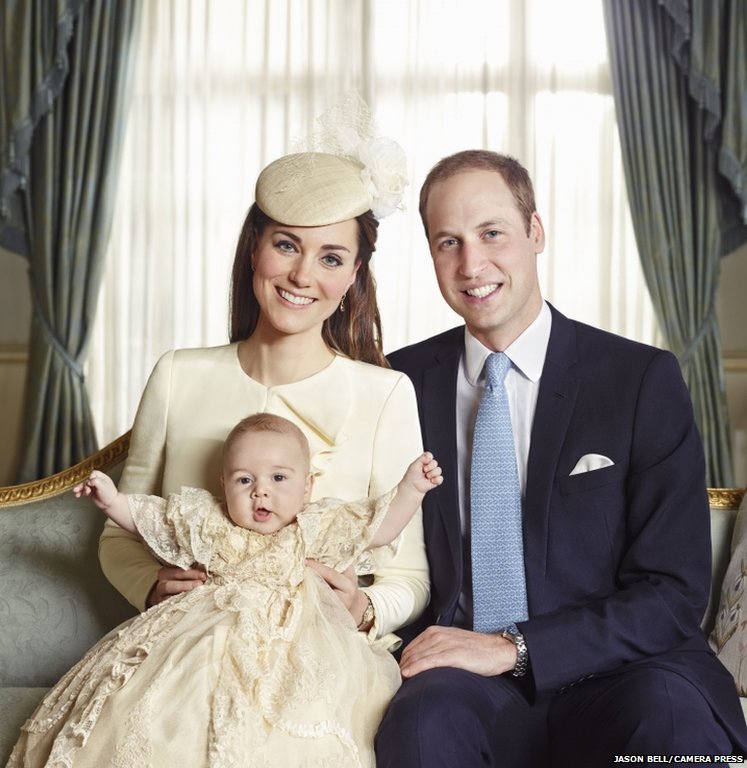
She has opened up palaces and royal treasures, launched royal websites, balanced the books, redefined the entire role of the modern monarchy and created a household run on merit rather than pedigree.
In doing so, she has quietly but steadily built secure new foundations beneath the throne for those three successors.
Opinion polls show that the monarchy is as popular today as it was more than 60 years ago, and that is no small achievement.
Because her success has been achieved slowly and without much noise, we have tended not to take much notice — beyond the occasional Jubilee.
We continue to take it for granted that the Queen will just carry on turning up and doing her stuff because she always does.
In less than two years, however, she will pass another milestone (there are still one or two to go).
In September 2015, she will overtake Queen Victoria to become the longest-reigning sovereign in our history.
While she will refuse to mark the occasion in any way, the rest of the world will surely acknowledge what it means.
The history of Britain is segmented and punctuated by the comings and goings of its Royal Family, by births, marriages and deaths.
Wednesday’s happy christening scene will command pride of place among the souvenirs and photographs jostling for space on the Queen’s famously crowded desk.
But it will be much more than a picture of a baptism. It will be the portrait of a reign
Last edited:
The Silver Cross: The pram loved by the royals for a century and still fit for Prince George
Set up in 1877, it produced the first royal pram for the Queen in 1927
It has been used by almost all her children, grandchildren and now George
William and Kate so attached they had their son's flown up to Scotland
By Martin Robinson
25 October 2013
Daily Mail
Daily Mail
It has been the royal family's pram of choice for almost a century and for William, Kate and Prince George, it is no different.
Considered 'the world’s most exclusive pram', a Silver Cross has carried the Queen, her children, grandchildren and now her three-month-old great-grandchild George.
The Cambridges are so attached to their one that they had it flown up to Scotland especially last month.
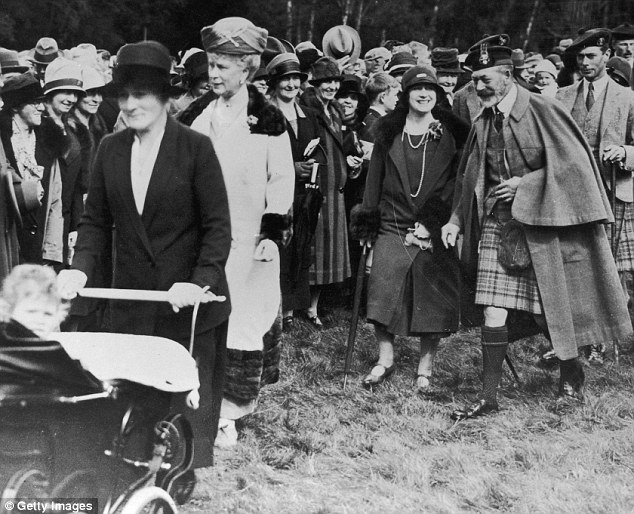
1927: The future Queen Elizabeth II is pushed in her Silver Cross pram followed by her grandmother Queen Mary (in the light coloured outfit); her mother, the future Queen Elizabeth, the Queen Mother (wearing the necklaces); her grandfather King George V; and her father, the future King George VI (far right), through the grounds of Balmoral
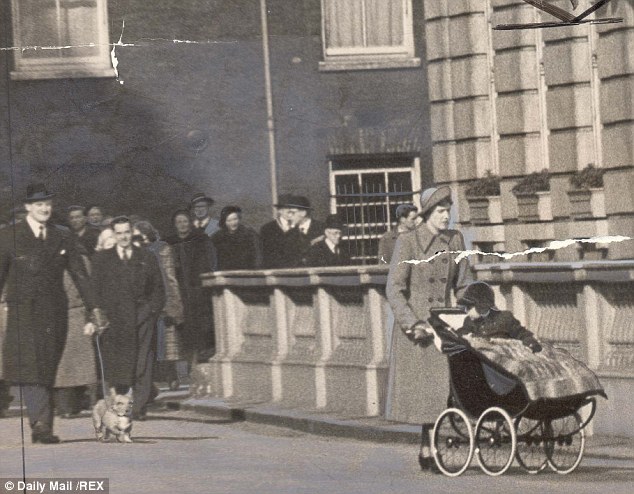
1952: Looking round to call one of his mother's Corgis, a young Prince Charles is walked to Clarence House in London in his luxury buggy

Tradition: George is carried by his mother after his christening this week, and just like generations of royals before him he is using a Silver Cross
William's own mother Diana spent her earliest days in the luxury buggy being pushed around her family's estate at Althorp in Northamptonshire.
Invented in 1877 by William Wilson, the baby carriages became hugely popular by the 1960s.
Both the Queen and Prince Charles spent some of their early months in a Silver Cross pram.
Television footage of Her Majesty pushing her children around royal estates in one helped turn them into a ‘must have’ baby accessory for the wealthy.
The prams were often spotted being pushed by Norland Nannies wearing their distinctive brown uniforms.
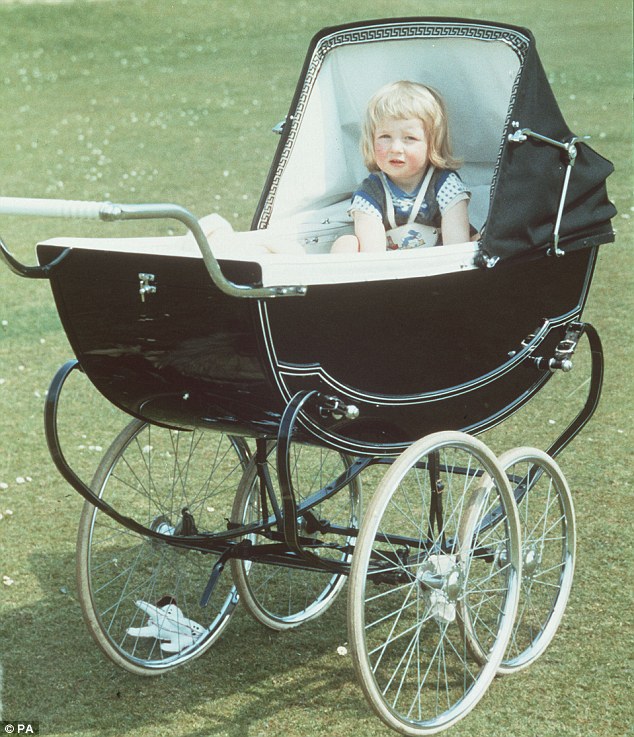
1963: Prince William's mother and Prince George's grandmother Diana, later Princess of Wales, sat in her buggy in the grounds of Althorp in Northamptonshire

1965: Queen Elizabeth II and Prince Philip with their children, Prince Charles, Princess Anne, Prince Andrew, and Prince Edward in his Silver Cross

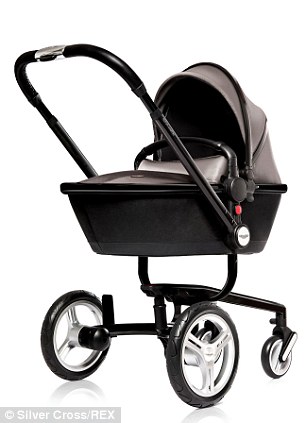
Prince George's? Silver Cross's latest Surf 007 pushchair, designed with the help of British luxury sports car manufacturer Aston Martin, James Bond's favourite
But as smaller and lighter prams and buggies came on the market, the tradition Silver Cross model faded in popularity.
The originals are probably considered a tad cumbersome by most 21st century parents, and many families would struggle to afford one – let alone get it through their front door.
But William and Kate have stuck with Royal tradition and ferry George around in a Silver Cross pram.
Buckingham Palace declined to reveal which model William and Kate opted for.
They might have chosen the £1,450 Silver Cross Balmoral pram which is described as the ‘ultimate classic pram’ by its designers.
Last edited:
Cute or just creepy? Pippa's unusual £7,000 christening gift to baby George - his hands and feet in silver by bespoke sculptors

Doting aunt Pippa Middleton (left) ordered the bespoke gift from Wrightson and Platt, a small London sculpting company which describes the gifts as 'a perfect keepsake to preserve precious memories in the finest materials'. The 'life cast', similar to those pictured (centre) would have been created from moulds made by dunking the baby prince's arms and legs in a jelly-like organic mixture made of water and a seaweed-based powder. It was one of a number of gifts received by the prince at his christening ceremony (right) on Wednesday.
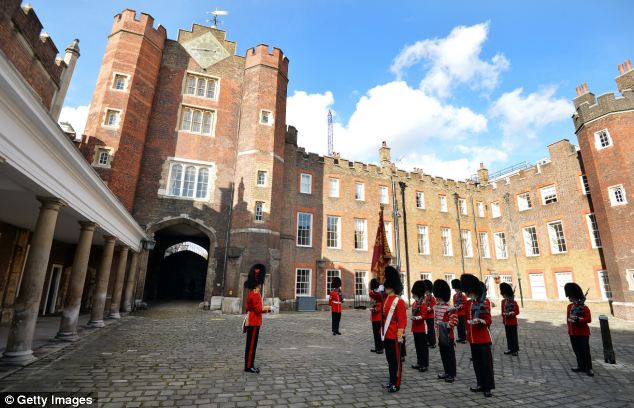
Colourful: The St James's Palace detachment of The Queen's Guard turns out in Colour Court, St James's Palace, for the arrival of Queen Elizabeth II, ahead of the christening
http://www.dailymail.co.uk/news/article-2477138/Cute-just-creepy-Pippas-unusual-7-000-christening-keepsake-baby-George--hands-feet-silver-bespoke-London-sculptors.html

Doting aunt Pippa Middleton (left) ordered the bespoke gift from Wrightson and Platt, a small London sculpting company which describes the gifts as 'a perfect keepsake to preserve precious memories in the finest materials'. The 'life cast', similar to those pictured (centre) would have been created from moulds made by dunking the baby prince's arms and legs in a jelly-like organic mixture made of water and a seaweed-based powder. It was one of a number of gifts received by the prince at his christening ceremony (right) on Wednesday.

Colourful: The St James's Palace detachment of The Queen's Guard turns out in Colour Court, St James's Palace, for the arrival of Queen Elizabeth II, ahead of the christening
Miss Middleton, party-planner and socialite, may have taken her inspiration from one of little George’s ancestors.
In the mid-1880s, Queen Victoria commissioned sculptor Mary Thorneycroft to carve her nine children’s hands, feet and limbs in alabaster.
The figures certainly influenced Denise Wrightson, one of the founders of Wrightson and Platt, to begin sculpting limbs in bronze, silver and gold.
A spokesman for Clarence House would not confirm or deny that the sculptures had been given as a present. He said: ‘If such a gift exists it would be a private gift and not be something we would be aware of.’
Meanwhile members of the Cabinet chose a more traditional gift for the baby prince – a hand-crafted pine toy box, which cost £400. Although for a slightly more modest option, they needed to go no further than George’s own grandfather, Prince Charles.
His Highgrove label has launched a range of baby gifts and toys, including a £195 ‘baby hamper’ with chamomile and mandarin organic toiletries.
The products retail for around £25 individually, and have ‘been developed to be calm and gentle on delicate skin’. The Highgrove website also offers a commemorative mug honouring George’s birth, for £20.
All profits from the sale of Highgrove products are donated to the Prince of Wales’s Charitable Foundation, a charity which supports a range of causes and organisations.
All profits from the sale of Highgrove products are donated to the Prince of Wales’s Charitable Foundation, a charity which supports a range of causes and organisations.
http://www.dailymail.co.uk/news/article-2477138/Cute-just-creepy-Pippas-unusual-7-000-christening-keepsake-baby-George--hands-feet-silver-bespoke-London-sculptors.html
Last edited:
Self-assessments are rarely accurate.Epic failure on your part.
All people aren't equal, are they?
For example, I consider myself to be of a higher class that a peasant on a sink estate.
Creepy, but funny; typical of things royal.Cute or just creepy?